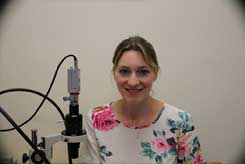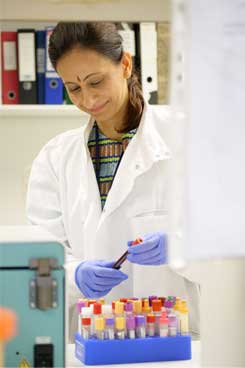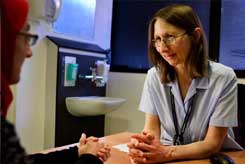Tuesday 23rd April 2024
RAIRDA Survey
Have your say on the way your services are working for your Rare Autoimmune Rheumatic Disease (RAIRD)
Funding important research into medical conditions is a crucial way in which medical research charities improve people’s lives. When a condition is rare like scleroderma, then that research becomes even more vital.
Funding important research into medical conditions is a crucial way in which medical research charities improve people's lives. When a condition is rare like scleroderma, then that research becomes even more vital.
At SRUK, we firmly believe that research saves lives, and so we are proud to fund the innovative research that will help our community and ultimately lead to a cure.
We fund and collaborate with such a great community of clinical researchers who are relentlessly working to understand the causes of Scleroderma and Raynaud's, how to detect these conditions earlier, and treatments that will finally cure them once and for all.
We've come very far in our understanding and treatment of Scleroderma and Raynaud's, but we have much further to go. Your continuing support means that we can work with scientists and clinicians to accelerate research even further.
In this article, we highlight three research studies funded by SRUK that we believe will make a difference across three key areas.
Cause
There are three main factors at play in systemic scleroderma: blood vessel abnormalities, inflammation and scar tissue formation.
Normally, when healthy skin is deprived of oxygen, proteins such as HIF and VEGF are produced by tissue cells to promote blood vessel formation. The new blood vessels formed are able to then provide the skin with oxygen through the blood supply. People who have Raynaud's syndrome and/or scleroderma can't form the new blood vessels properly, which means that the skin continues to be deprived of oxygen. This leads to painful complications like digital ulcers and in severe cases, internal organ problems.
In people who have scleroderma, clinical researchers often detect high levels of HIF and VEGF but its thought that there is something wrong with the proteins. This is because during the early phase of scleroderma, large blood vessels seem to form but as the condition progresses, new blood vessel formation can't be detected.

Dr. Victoria Flower, who is based in Bath, is working to understand what causes HIF and VEGF to be abnormally produced during the early and later stages of scleroderma. If she can identify a protein or other molecule then that means we can potentially apply this as a therapy so that HIF and VEGF can be produced normally and form new blood vessels.
Her study involves collaborating with people who have systemic scleroderma to take small skin biopsies that can then be cultured in the lab and used to test various therapeutics and interventions. During these tests, HIF and VEGF are monitored closely to determine whether there is any effect. This work is crucial because it isn't just working to find a cause, its working to find a treatment.
Recruitment of people with systemic sclerosis is continuing to be a success, with a huge amount of interest from community members. We are expecting to be able to share the results of this crucial work by spring next year.
Detection
Each person with systemic scleroderma will experience their condition differently. This means that while some people may only experience lung involvement, others may have both heart and lung involvement, which in many cases can be fatal.
Heart involvement is very serious and is one of the biggest causes of death for people with the condition. If heart involvement can be detected earlier, then better treatment can be given to help people with the condition. Current methods of detecting heart involvement, like echocardiograms and electrocardiograms, only monitor the heart during discrete periods of time.

This means that due to a lack of consistent monitoring early signs of heart problems can be missed.
Professor Maya Buch at the University of Leeds is carrying out a long-term study to see whether an implantable cardiac monitor can detect early heart problems in people with systemic scleroderma. Any signs of involvement that she can detect can then be used to help other people with systemic scleroderma who may not have heart involvement yet, as they can be monitored to determine whether they present with the early signs of heart involvement.
Early work in this study has shown that significant cardiac problems such as arrhythmias have been identified in people with systemic scleroderma who have not had any previous associated heart conditions. This means that early and potentially saving treatments have been applied and are proving to be effective. Although this study is still a long way away from completion, these early results could be very promising.
Treatment
Calcinosis is the formation of painful white calcium lumps that form under the skin on hands, feet and other body areas. They can form in small lumps and clusters and in some cases, they break through the skin. Calcinosis occurs in 40% of scleroderma patients and the cause is still unknown.
At the moment there is no cure for calcinosis. There is also no real treatment, with patients being told to seek regular medical advice in case of an infection due to skin breakage. Surgery is sometimes used to remove larger calcium masses, however, that is considered a crude approach and does not completely remove the lumps.

Professor Ariane Herrick, based in Manchester, is collaborating with Professor Richard Winpenny, also at the University of Manchester, to investigate the possibility of a treatment that could dissolve the bony lumps under the skin. Having worked together previously, their work has demonstrated that the lumps are primarily formed of a substance called carbonate hydroxyapatite.
They are combining their areas of expertise, chemistry and medicine, to create a treatment that can be applied to the skin and then pass through the skin barrier to dissolve the bony lumps formed because of calcinosis. They're investigating the properties of various topical substances in order to determine which one will be most efficacious in dissolving the deposits without any harm to the surrounding healthy tissue. They are also collaborating to better characterise the lumps so that they can determine what else the deposits are made of.
Funding from SRUK has meant that four substances that were identified as part of this study are now being studied further to determine if they are suitable for use as topical agents in humans. This means that in a few short years, there could be a clinically proven topical treatment for calcinosis that is readily available for this painful condition.
Support our world class research programme
We fund ground breaking research that has the potential to make a significant difference to the lives of people affected by Scleroderma and Raynaud's.
With your support we can accelerate research to impact lives today, not tomorrow.
Tuesday 23rd April 2024
Have your say on the way your services are working for your Rare Autoimmune Rheumatic Disease (RAIRD)
Tuesday 19th March 2024
The Scleroderma and Raynaud’s UK sponsored 'Science in Medicine School Teams Prize 2024' contest is now open for entries. The contest aims to engage sixth form school students with science in medicine, and challenges students to prepare an ePoster with a novel vision on how to promote the health and well-being of individuals with Scleroderma and/or Raynaud’s. If you're interested in entering, or know someone in sixth form who might be, read on to find out more!
Wednesday 28th February 2024
As high bills continue to threaten the health of those living with the debilitating condition; SRUK is appealing to energy companies to provide financial assistance to them.